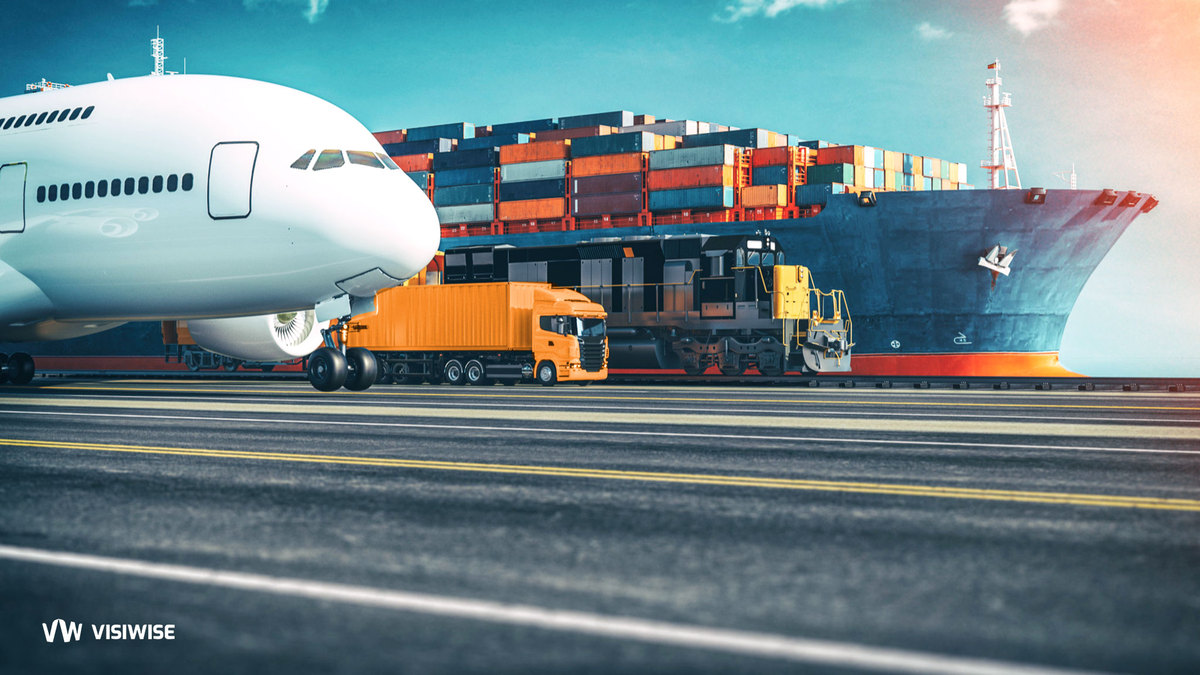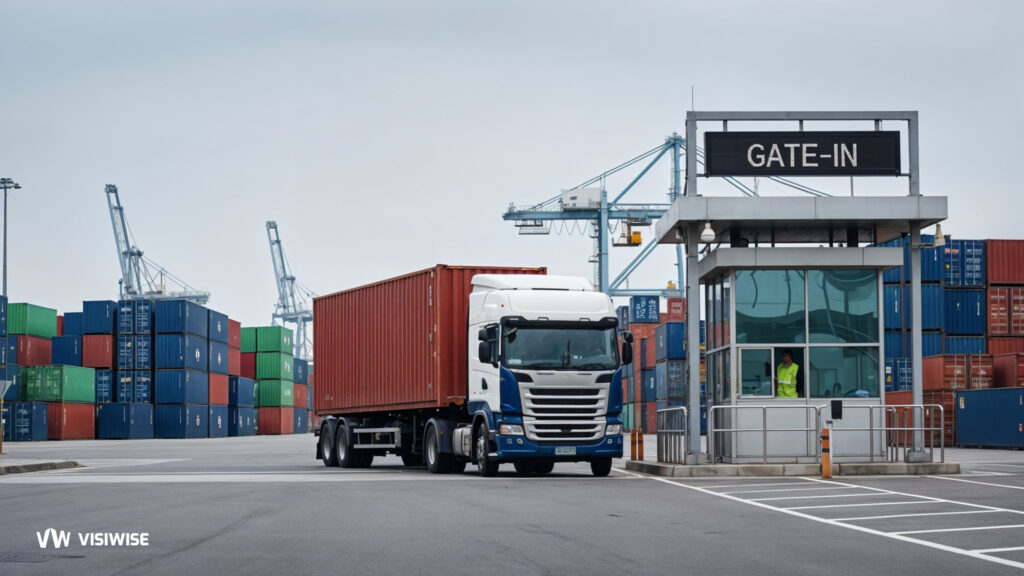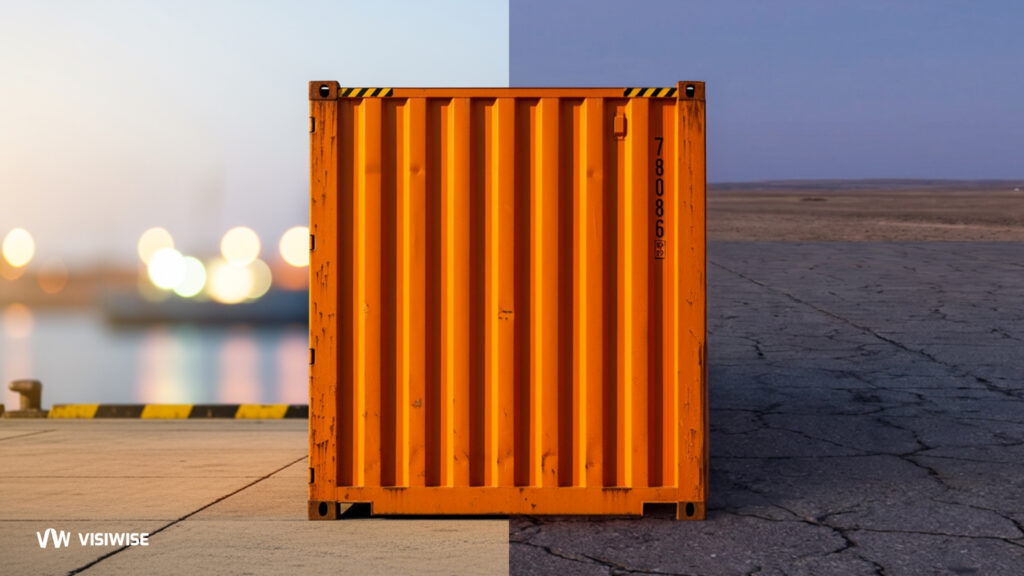Navigating the intricate channels of global trade, intermodal shipping has emerged as a linchpin, seamlessly blending various modes of transportation for efficient goods transit. At the heart of this interconnected system lies the pivotal practice of tracking cargos in real-time. This dynamic process involves closely monitoring the journey of goods across diverse transportation modes, harnessing cutting-edge technologies like GPS, RFID, IoT, and blockchain.
Cargo tracking isn’t just a logistical necessity; it’s a game-changer for stakeholders across the supply chain. It provides a window into the location, status, and condition of goods, empowering decision-makers with real-time insights. Through the lens of advanced technologies, we’ll navigate the terrain of cargo tracking—unraveling its challenges, embracing its benefits, and unveiling its transformative role in reshaping the future of global logistics. Join us on this journey into the pulse of intermodal shipping.
Intermodal Freight Transport in A Nutshell
Intermodal freight transport involves moving cargo in intermodal containers or vehicles across different transportation modes, including rail, ship, aircraft, and truck. The key feature is that the freight undergoes no handling when transitioning between modes. This approach enhances security, reduces the risk of damage and loss, and speeds up the transportation of goods. The primary advantage of intermodal transport for long-distance shipping is cost reduction compared to road trucking. However, for shorter distances, the time efficiency of road transport may offset these benefits.
Intermodal Tracking
Intermodal tracking refers to the monitoring and tracing of shipments as they move through different modes of transportation within an intermodal logistics network. This involves the use of technology and systems to provide real-time visibility into the location, status, and condition of goods as they transition between various transportation methods, such as rail, ship, aircraft, and truck.
Key aspects of intermodal tracking
1. Holistic Supply Chain Visibility:
Intermodal tracking, with a special emphasis on intermodal container tracking, provides comprehensive visibility throughout the entire supply chain. It enables stakeholders to seamlessly monitor the movement of goods as they transition through diverse transportation modes, ensuring a holistic view.
2. Real-time Monitoring:
Employing technologies like GPS, RFID, and telematics, intermodal container tracking facilitates real-time monitoring of not only the shipment’s location but also specific details about the container, including temperature, humidity, and security parameters.
3. Integrated Platforms for Holistic Information:
Intermodal tracking systems are typically integral components of comprehensive logistics platforms that consolidate data from various sources, such as carriers, terminals, and customs authorities. This integration ensures a cohesive and accurate flow of information.
4. Automated Alerts and Notifications:
The tracking platforms, especially those focusing on intermodal container tracking, feature automated alert systems that promptly notify stakeholders of any deviations from the planned route, delays, or other critical events. This proactive approach aids in decision-making.
5. Documentation Management and Container Tracking:
Beyond tracking the shipment’s location, these systems manage and track essential documents, such as bills of lading and customs paperwork. The emphasis on intermodal container tracking extends to monitoring the documentation associated with each container in transit.
6. Collaboration Tools for Enhanced Communication:
Effective intermodal tracking, including intermodal container tracking, involves seamless collaboration between different supply chain stakeholders. The platforms incorporate collaboration tools that facilitate efficient communication and information sharing.
7. Data Analytics for Optimization:
Leveraging data analytics, intermodal tracking platforms provide valuable insights into the performance of the entire logistics network. This analytical approach helps identify areas for optimization and continuous improvement.
8. Regulatory Compliance Across Modes:
Intermodal tracking systems play a crucial role in ensuring compliance with diverse regulations governing the movement of goods across different transportation modes and international borders.
9. Customer Visibility and Container Tracking:
Some intermodal tracking solutions extend visibility to end customers, enabling them to track their shipments and receive real-time updates. This customer-centric approach enhances transparency and satisfaction, particularly in the context of intermodal container tracking.
10. Minimized Cargo Handling Risks:
Intermodal container tracking minimizes the necessity for manual cargo handling during transitions between transportation modes. This reduction in physical handling mitigates the risks associated with damage, loss, and errors, safeguarding the integrity of the cargo.
11. Enhanced Security Measures:
The heightened visibility and tracking capabilities contribute to improved security for shipments. Automated alerts and notifications enable the timely detection and response to any anomalies or deviations from the planned route, enhancing overall security measures.
12. Optimized Resource Utilization:
By leveraging intermodal container tracking, companies can optimize the utilization of transportation resources. This strategic selection of the most efficient mode for each leg of the journey leads to cost reduction, minimized transit times, and improved resource efficiency.
13. Cost Savings, Especially for Long-Distance Shipping:
Intermodal container tracking significantly contributes to cost reduction, particularly in the context of long-distance shipping. By optimizing transportation routes and modes, businesses can achieve substantial cost savings compared to relying solely on road trucking.
14. Environmental Considerations and Sustainability:
With a focus on environmentally friendly transportation modes for specific legs of the journey, intermodal container tracking supports sustainability goals. This aligns with the growing emphasis on environmentally responsible practices within the supply chain.
15. Enhanced Customer Satisfaction:
Providing customers with end-to-end visibility, accurate tracking information, and timely updates enhances overall satisfaction. The inclusion of intermodal container tracking ensures customers have confidence in the reliability and transparency of the supply chain.
16. Data-Driven Decision-Making Insights:
The data generated by intermodal container tracking systems offers valuable insights for analysis. This data-driven approach facilitates informed decision-making, allowing businesses to identify trends, address bottlenecks, and continuously optimize their supply chain operations.
The data generated by intermodal container tracking systems offers valuable insights for analysis. This data-driven approach facilitates informed decision-making, allowing businesses to identify trends, address bottlenecks, and continuously optimize their supply chain operations.
Intermodal Tracking Tips, Benefits, and Tricks
- Benefit: Gain immediate insights into the location and status of shipments across different transportation modes.
- Tip: Regularly check real-time tracking updates to stay informed about the progress of your shipments.
2. Automated Alerts:
- Benefit: Receive instant notifications about any deviations, delays, or critical events.
- Tip: Set up automated alerts to proactively address issues and minimize disruptions in the supply chain.
3. Container-Specific Tracking:
- Benefit: Monitor individual containers, ensuring detailed visibility into conditions and security.
- Tip: Focus on intermodal container tracking to enhance granularity in monitoring and management.
4. Documentation Integration:
- Benefit: Streamline document management, reducing administrative burdens and minimizing errors.
- Tip: Choose platforms that seamlessly integrate with documentation systems to enhance efficiency.
5. Collaboration Tools:
- Benefit: Foster clear communication channels among stakeholders involved in the supply chain.
- Tip: Utilize collaboration tools within the tracking platform for efficient information sharing.
6. Security Enhancements:
- Benefit: Improve overall security measures by detecting and responding to anomalies.
- Tip: Regularly review and enhance the security features of the tracking system to safeguard sensitive data.
7. Data Analytics for Optimization:
- Benefit: Analyze tracking data to identify trends and optimize supply chain operations.
- Tip: Leverage analytics tools to make informed decisions and continuously improve efficiency.
8. Training Programs:
- Benefit: Ensure personnel are well-versed in utilizing tracking features and functionalities.
- Tip: Provide comprehensive training programs to users to maximize the benefits of the tracking system.
9. Customization for Diverse Shipments:
- Benefit: Tailor tracking parameters to suit the unique requirements of different types of shipments.
- Tip: Use customizable settings to adjust tracking criteria based on factors such as cargo sensitivity, delivery urgency, or specific handling requirements.
10. Enhanced Mobile Accessibility:
- Benefit: Align with environmental responsibility by selecting sustainable transportation modes.
- Tip: Integrate sustainability practices where possible to support corporate green initiatives.
11. Proactive Issue Resolution:
- Benefit: Identify and address potential issues before they escalate, minimizing disruptions.
- Tip: Regularly review historical data and performance metrics to anticipate and proactively mitigate recurring challenges.
12. Customization for Diverse Shipments:
- Benefit: Tailor tracking parameters to suit the unique requirements of different types of shipments.
- Tip: Use customizable settings to adjust tracking criteria based on factors such as cargo sensitivity, delivery urgency, or specific handling requirements.
13. Enhanced Mobile Accessibility:
- Benefit: Access tracking information on-the-go, improving responsiveness and decision-making.
- Tip: Choose platforms equipped with mobile applications or responsive interfaces to ensure effortless tracking accessibility across various devices.
- Top of Form
14. Predictive Analytics for Optimization:
- Benefit: Utilize predictive analytics to forecast potential bottlenecks and optimize logistics processes.
- Tip: Leverage historical data and machine learning algorithms to predict future trends, enabling proactive decision-making and resource allocation.
15. Continuous System Updates:
- Benefit: Stay current with the latest features, security patches, and improvements.
- Tip: Regularly check for and install system updates to ensure optimal performance, security, and access to new functionalities.
16. Global Positioning System (GPS) Enhancements:
- Benefit: Leverage advanced GPS technologies for more accurate and reliable location tracking.
- Tip: Stay informed about emerging GPS technologies and consider their integration for even more precise location data.
17. Blockchain Integration for Transparency:
- Benefit: Enhance transparency and data integrity by exploring blockchain integration.
- Tip: Investigate blockchain solutions to create an immutable and transparent ledger of tracking events, ensuring data accuracy and authenticity.
18. Integration with IoT Devices:
- Benefit: Extend tracking capabilities with Internet of Things (IoT) devices for real-time monitoring of environmental conditions.
- Tip: Explore IoT sensors for monitoring factors like temperature, humidity, and shock, ensuring the integrity of sensitive cargo.
19. Diverse Mode Monitoring:
- Benefit: Monitor shipments seamlessly as they transition between various transportation modes.
- Tip: Choose a tracking platform that excels in intermodal visibility, offering consistent monitoring regardless of the mode of transportation.
20. User Feedback Integration:
- Benefit: Encourage user feedback to continually enhance the tracking platform based on user experiences.
- Tip: Implement feedback mechanisms to gather insights from users, facilitating ongoing improvements to the tracking system’s usability and effectiveness.
Intermodal Visibility with Visiwise: Experience a New Standard
Efficient supply chain visibility is a paramount objective, aiming to seamlessly integrate the diverse facets of multimodal transportation and present a unified perspective to all stakeholders. While some segments of the supply chain easily integrate into this visibility framework, others pose complexities. Notably, ocean and intermodal components stand out as intricate and demanding elements within the visibility puzzle. Unlike trucks equipped with telematics and IoT devices, containers in the ocean and intermodal sectors often lack such advanced tracking capabilities, and the numerous handoffs at ports further compound the challenge.
Despite the intricacies, these segments hold immense significance. Ocean and intermodal transport set the groundwork for the entire supply chain journey, playing a pivotal role in proactive planning. Recognizing the critical nature of these challenges, our focus at Visiwise is dedicated to addressing and resolving them. We are committed to delivering the most comprehensive visibility product available in the market, ensuring that users have a holistic understanding of their supply chain dynamics.
In our pursuit of enhancing visibility, the introduction of intermodal tracking capabilities represents a significant leap forward. At Visiwise, we understand the intricacies involved in intermodal transportation and have embarked on a journey to provide end-to-end visibility that encompasses even the most challenging aspects. Allow us to guide you through our approach to tackling the complexities inherent in intermodal tracking and shipment visibility.
Visiwise Revolutionizes Intermodal Tracking with Precise ETAs
Efficient supply chain management demands accurate Estimated Time of Arrivals (ETAs), especially for shipments crossing oceans. Visiwise’s monitoring vessel routes, offers unparalleled intermodal tracking and predictive analytics.
Vessel Route Expertise
Visiwise’s extensive data repository includes detailed insights on vessel speeds, delays, and port congestion. This wealth of information enables precise calculations of ship movements and accurate ETAs for any point on the water.
Weather and Route Optimization
Monitoring weather conditions and their influence on potential routes and vessel speeds is integral to our tracking capabilities. Although we cannot prevent Estimated Time of Arrivals (ETAs) from fluctuating, we excel in providing customers with the most precise, real-time ETAs and transparent insights into the reasons for any changes. This empowers them to plan effectively, enhancing overall operational efficiency.Top of Form
Comprehensive Supply Chain Visibility
Visiwise revolutionizes intermodal tracking by seamlessly integrating data from the entire ecosystem, providing real-time container tracking down to the container level.
Top Integrations for Holistic Visibility
With strategic integrations with leading ocean carriers, Visiwise ensures visibility into container-level event data, route plans, live vessel tracking, and geo-location updates. The platform also incorporates data from ports and terminals, offering insights into customs, line and terminal hold status, detention risks, and key events for efficient intermodal handoffs.
Modern API Architecture for Connectivity
Built on modern APIs, Visiwise’s platform facilitates extensive connectivity, enabling the transfer of high volumes of data. This robust ecosystem ensures end-to-end visibility, a result of years invested in building a platform that connects stakeholders seamlessly.
Single Source of Truth for Full Lifecycle Visibility
Visiwise consolidates data from ocean, intermodal, and other transportation modes into a centralized platform, providing users with a single source of truth. This approach ensures that stakeholders have a holistic view of their supply chain, minimizing uncertainties during handoffs and optimizing operations.
Stitching Together the Visibility Picture
Ocean and intermodal visibility offered by Visiwise contribute to a complete supply chain visibility picture. By seamlessly tracking inbound containers and minimizing uncertainties during handoffs, the platform feeds into the Advanced Visibility Platform, empowering customers to grasp the bigger picture of their logistics operations.
Final Thoughts
the intermodal tracking sector is undergoing a transformative shift with integrated data across the entire ecosystem. Highlighting container-level tracking, strategic collaborations with ocean carriers, modern API architecture, and a commitment to a singular source of truth redefine supply chain visibility. Integrating insights from ports and terminals, the sector provides a comprehensive view of the intermodal journey, enhancing efficiency in handoffs. The modern API architecture ensures seamless connectivity, consolidating data for end-to-end visibility. This industry contribution to a complete supply chain visibility picture is crucial in navigating the complexities of global logistic



